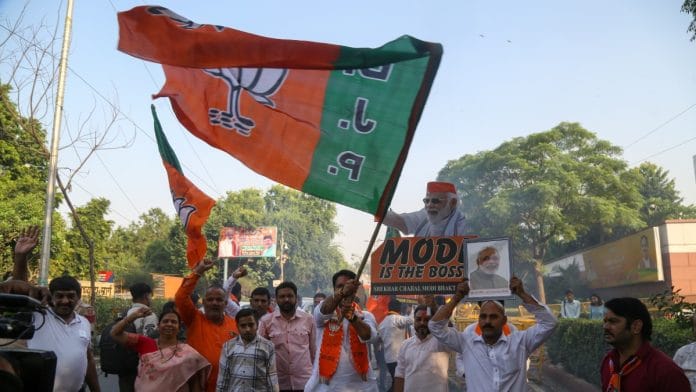New Delhi: If exit polls were to be believed, Haryana was a done deal for the Congress. Until it wasn’t. Having lost pole position in the Lok Sabha elections just months earlier, the BJP has managed to stage a spectacular comeback in the state, poised to finish well past the majority mark.
BJP’s Haryana state in-charge Satish Poonia told ThePrint, “The BJP ticked all the boxes and managed the odds to counter anti-incumbency.”
For the BJP, course correction in Haryana included better coordination with the RSS, mapping of booths, removing Manohar Lal Khattar as chief minister, and a counter-polarisation push among OBCs by repeatedly raking up the name of Bhupinder Singh Hooda to drive home the message that a Congress win would amount to Jat ‘domination’. Focus on GT Road and Ahirwar belts was also a key part of the BJP’s strategy in the state, as was replacing Khattar with Nayab Singh Saini, an OBC, as chief minister.
EC trends show the BJP securing 40 percent vote share and winning 48 seats, more than its tally of 47 seats in the 2014 assembly elections. The turnaround in Haryana is a shot in the arm ahead of elections, in Maharashtra, Jharkhand and Delhi in the coming months.
Having retained power in Haryana for a third consecutive term, the BJP has once again flexed its organisational machinery.
Unlike Karnataka, where BJP is said to have lost power largely due to graft charges, the Haryana model was praised for transparency in administration during Khattar’s tenure. This was also seen in contrast with allegations of ‘kharchi-parchi’ against the Hooda-led Congress government (2005-14).
Though Khattar was later removed at the advice of the RSS which held that he had alienated the Jat community, the BJP’s decision to replace him with Saini allowed it to counter a decade’s worth of anti-incumbency sentiment.
Its decision to project Saini alongside Prime Minister Modi in public meetings across the state was how the BJP fractured the Jat vote and consolidated the non-Jat vote. With this outcome, Haryana is now also in the list of states where replacing its chief minister has helped the BJP overcome anti-incumbency, the others being Gujarat and Uttarakhand.
A state BJP leader told ThePrint, “In Haryana, Bhajan Lal ruled for many years with the help of effective counter-polarisation among less dominant castes. By giving a share of power to the largest block among the OBCs with the appointment of Saini, BJP rectified its mistake and sent out a message.”
“Welfare schemes were implemented and recruitment done without kharchi, parchi (bribery, favouritism) during Khattar’s tenure. BJP amplified the message that a government led by Hooda will favour only the dominant caste (Jats). Amit Shah said so at a rally,” the leader said.
He went on to add that the BJP held on to its support base along the GT Road and Ahirwar belts on account of its developmental works and efforts of Rao Inderjeet Singh, respectively. “This time all tickets were given after consultation with Rao Inderjeet Singh since it was understood that only he can save the BJP in Haryana, and he did not let the party down.”
RSS push, micro-management
Not long after the party suffered a major setback in the Lok Sabha polls, losing seats in Haryana and Maharashtra, the BJP high command held several rounds of talks with the RSS leadership to shore up defences ahead of assembly elections in various states.
In the case of Haryana, the responsibility to oversee coordination between the party and the Sangh fell on the shoulders of RSS joint general secretary Arun Kumar. He first held a meeting with CM Nayab Singh Saini and Union Minister Dharmendra Pradhan, who is also election incharge of Haryana.
It was during these meetings that in-depth discussions were held on strategy and candidate selection. It was also decided to deny tickets to candidates the RSS disapproved of, it is learnt. This, combined with Amit Shah’s instructions to map booths across the state, gave the BJP an edge.
Moreover, RSS was tasked with increasing the voting percentage in rural seats. To that effect, it launched a rural voter outreach in September with 150 volunteers in each district.
A second Haryana BJP leader told ThePrint, “Our strategy was clear, to focus on strongholds—Ahirwar and GT Road belts—and to not lose urban seats at any cost. Since economic hardship was a pressing issue in rural seats, the party concentrated on urban strongholds to minimise losses.”
A third Haryana BJP leader said the Congress “became complacent” and bought into the idea that there was a wave in favour of the party. “They did not make use of the opportunity. BJP made every effort to negate the odds, from micromanaging booths to putting cadres to work, dropping sitting MLAs and denying tickets to those with a negative report card. This was unlike the Congress, which gave tickets to most Hooda loyalists, was unable to address infighting. The Selja-Hooda controversy too played well.”
The BJP, said party sources, had decided to keep CM Saini and Rao Inderjeet Singh front and centre of its campaign in Haryana. “BJP kept the campaign focussed on local leaders and local issues,” said one party leader.
A BJP strategist who did not wish to be named, added, “First, it was decided that nobody from the party would comment on Vinesh, to not consolidate anger over the wrestlers’ issue; similarly, when the party realised the Agniveer issue and anger among the youth can boomerang, the BJP promised government employment for Agniveers in Haryana.”
At some point the party realised that organised the Prime Minister’s public meetings is a mammoth exercise and it was decided to hold smaller meetings to mobilise cadres and reach out to more voters, said party insiders.
(Edited by Amrtansh Arora)
Also Read: BJP’s Sunil Sangwan, ex-jailer in whose tenure Ram Rahim got out 6 times, wins Dadri by slim margin






